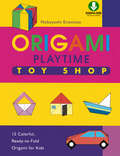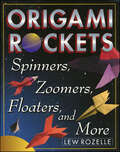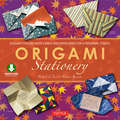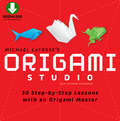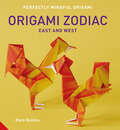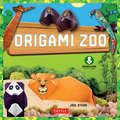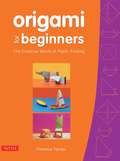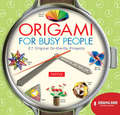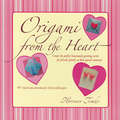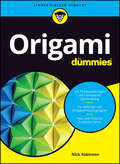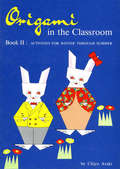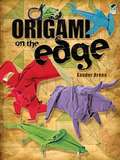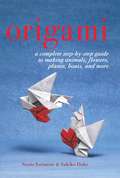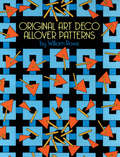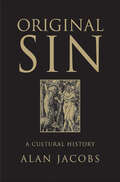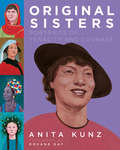- Table View
- List View
Origami Playtime Book 2 Toy Shop
by Nobuyoshi EnomotoOrigami Playtime Book 2 Toyshop, contains 15 colorful , ready-to-fold origami for kids. You'll fold yachts, planes, boxes, houses, books, televisions and many other fun, innovative objects.
Origami Rockets: Spinners, Zoomers, Floaters, and More
by Lew RozelleThey float! They fly! They zoom! They spin! They even land on their feet! Origami Rockets: Spinners, Zoomers, Floaters, and More presents how to create inflatable paper folding projects that actually take flight. From a few basic designs, this how to do orgami book offers more than fifty unique paper toy rocket creations including: -Sweptwing rockets-Landers-Gliders-Shortnosed spinner-And even a lunar landerWith step-by-step instructions on how to fold and inflate rockets into three-dimensional crafts, this origami how to book also features directions on the best methods of throwing their rockets and making them soar. In addition, advanced paper folders will learn how to develop new designs and experiment with making rockets that will go farther, higher, and faster.No cutting or gluing required! With Origami Rockets, even beginners can create flying machines with only paper and air.
Origami Stationary Kit
by Michael Lafosse Richard AlexanderMake beautiful, hand-made origami envelopes, note cards and other stationary with this great origami ebook! One of the casualties of the digital age is the elegance of a handwritten note. World renowned origami artist Michael LaFosse introduces Origami Stationery which allows origami paper craft folders to create more than just a note, but a work of art that will accent your personal messages. These folded pieces of easy origami art make an ideal accompaniment to a gift, or to commemorate a holiday or birthday, or just for sending a heartfelt message to a friend or loved one and are a great way to learn origami techniques. This do-it-yourself ebook includes: A full-colored 64-page booklet clear step-by-step instructions and easy-to-follow diagrams 15 fun origami projects In this origami ebook you will find both traditional and modern examples of the art of the folded note. The scope is from simple origami to intricate origami art; abstract to representational; somber to whimsical: a wide range of paper folding possibilities! Custom printed papers are included to make your notes well dressed for any occasion. Once you learn how to fold any of these origami designs you can explore many kinds of fine papers for your notes. All of the projects use square shaped paper, which doesn't necessarily need to be origami paper. You will soon have your favorites committed to memory. Then it will be easy to whip up a quick origami note for a "Thank you!", "Sorry I missed you," or "Congradulations!" Even the humblest papers are elevated to elegance by paper folding. Origami projects include: Flapping Bird Envelope Pillow Note Twist Note Hashi Wrapper Note And many more... Sending cards and personal notes has never been so much more fun with Origami Stationery!
Origami Stationery
by Michael G. Lafosse Richard L. LafosseMake beautiful, hand-made origami envelopes, note cards and other stationary with this great origami ebook!One of the casualties of the digital age is the elegance of a handwritten note. World renowned origami artist Michael LaFosse introduces Origami Stationery which allows origami paper craft folders to create more than just a note, but a work of art that will accent your personal messages. These folded pieces of easy origami art make an ideal accompaniment to a gift, or to commemorate a holiday or birthday, or just for sending a heartfelt message to a friend or loved one and are a great way to learn origami techniques.This do-it-yourself ebook includes: A full-colored 64-page booklet clear step-by-step instructions and easy-to-follow diagrams 15 fun origami projects In this origami ebook you will find both traditional and modern examples of the art of the folded note. The scope is from simple origami to intricate origami art; abstract to representational; somber to whimsical: a wide range of paper folding possibilities! Custom printed papers are included to make your notes well dressed for any occasion. Once you learn how to fold any of these origami designs you can explore many kinds of fine papers for your notes. All of the projects use square shaped paper, which doesn't necessarily need to be origami paper. You will soon have your favorites committed to memory. Then it will be easy to whip up a quick origami note for a "Thank you!", "Sorry I missed you," or "Congradulations!" Even the humblest papers are elevated to elegance by paper folding.Origami projects include: Flapping Bird Envelope Pillow Note Twist Note Hashi Wrapper Note And many more...Sending cards and personal notes has never been so much more fun with Origami Stationery!
Origami Studio
by Richard L. Alexander Michael G. Lafosse**Winner of the 2012 Oppenheim Toy Portfolio Platinum Best Video Award**This award-winning origami teaches origami beginners all the most important folds and techniques.Welcome to Origami Studio -an artist's workshop! This all-inclusive origami paper craft ebook with downloadable material will teach you to easily create beautiful origami as if you are right in the studio. World renowned origami master, Michael LaFosse will guide you step-by-step though 30 carefully crafted lessons. You will move seamlessly from origami beginning to intermediate all at your own pace. Origami Studio teaches an understanding of origami terminology, the ability to easily read diagrams, a mastery of fine techniques and bases, and discovery of tips, tricks and secrets of one of the world's most foremost folders. Although the easy-to-follow instructions make this a great origami for kids ebook, it is also serious and challenging enough for adult learners looking to learn origami and get a solid foundation in the art of origami paper folding. The origami ebook includes: Full-color 72-page booklet Step-by-step instruction and diagrams 30 fun lessons Downloadable material Easy-to-follow demonstrations for each of the 30 lessonsNo matter your age, or previous paper folding experience, these projects and techniques will help you become a better origami folder. Frustrating objects are easily removed by explaining what is going on on a fundamental level. By mastering the basics of origami you will soon be able to advance to much more difficult and rewarding projects and enjoy a lifetime of joy folding and sharing your designs with friends and family.Paper folding projects Include:Elsa's SwanJapanese Inflatable FrogPillow NoteLily FlowerBunnyStar Box and much more...
Origami Toy Monster
by Andrew DewarWhat could be more fun than making your own origami monster and watching it come to life!<P><P> With Origami Toy Monsters Kit, kids and parents alike will see their very own visually captivating paper craft creations, known as karakuri, traditional Japanese mechanized puppets, shudder and lurch right before their eyes!
Origami Toys
by Florence TemkoOrigami Toys shows you how to make many paper toys and games that are fun for both children and adults. If you have ever folded a paper airplane you have already tried origami. Origami is the craft of folding a piece of paper into a recognizable object, using only your hands, which is exactly how you made the airplane. Many people are fascinated with origami and find it to be a relaxing, yet challenging hobby. Origami Toys contains a lot of practical information, including: Step-by-step instructions How to make unique decorations How to create new designs How to use different papers How to teach origami How to use origami as an educational tool How origami fits into the world of computers and technology
Origami Toys
by Florence TemkoOrigami Toys shows you how to make many paper toys and games that are fun for both children and adults. If you have ever folded a paper airplane you have already tried origami. Origami is the craft of folding a piece of paper into a recognizable object, using only your hands, which is exactly how you made the airplane. Many people are fascinated with origami and find it to be a relaxing, yet challenging hobby. Origami Toys contains a lot of practical information, including: Step-by-step instructions How to make unique decorations How to create new designs How to use different papers How to teach origami How to use origami as an educational tool How origami fits into the world of computers and technology
Origami Zodiac: East and West (Perfectly Mindful Origami Ser.)
by Mark BolithoEmbark on a paper-folding journey through western and eastern astrology that will inspire creativity and contemplation—from the author of Zoogami.This covetable collection of perfectly mindful origami includes twenty-five inventive paper projects for all signs of the zodiac, both eastern and western. From an elegant dragon and a complex scorpion to a stylized monkey and a classic rooster, each project is superbly designed and clearly explained with fully illustrated step-by-step instructions. Whether you are an origami beginner or a seasoned paper crafter looking for a more complex challenge, Perfectly Mindful Origami will exercise your mind while clearing it of clutter.
Origami Zoo Kit
by Joel SternChildren and beginners will love folding origami animals of every kind with this easy origami-for-kids kit. Origami Zoo Kit is designed to stimulate your child's imagination and creativity through the age-old art of paper folding. It contains instructions and patterned folding papers for thirteen adorable animals along with life-like trees and people (zoo visitors) who together form a complete zoo. Each character comes with simple folding instructions and the colorful papers can be folded up in just a few minutes. Stickers are provided to add finishing details to the models. Kids can then play with the animals on the fold-out zoo map that is provided. This map also has a coloring activity on the back! This origami kit contains: Full-color 48 page booklet Clear, step-by-step diagrams and instructions 15 fun origami projects 95 animal parts stickers 40 sheets of origami paper Fold-out zoo map The Origami Zoo Kit will provide hours of enjoyment for your kids while at the same time teaching them a valuable new skill!
Origami for Beginners
by Florence TemkoOrigami is an ideal craft for children since paperfolding develops dexterity and creativity. Origami is also a craft based on a few fundamental techniques, so Origami for Beginners is a useful starting point for origami fans of all ages and abilities.There is something for everyone in Origami for Beginners. Over forty, easy-to-make objects will appeal to a wide-ranging audience. There are jumping mice and adorable kittens as well as beautiful Christmas ornaments and gift boxes.This is the perfect book for anyone who enjoys creating with their hands.
Origami for Beginners
by Florence TemkoOrigami is an ideal craft for children since paperfolding develops dexterity and creativity. Origami is also a craft based on a few fundamental techniques, so Origami for Beginners is a useful starting point for origami fans of all ages and abilities.There is something for everyone in Origami for Beginners. Over forty, easy-to-make objects will appeal to a wide-ranging audience. There are jumping mice and adorable kittens as well as beautiful Christmas ornaments and gift boxes.This is the perfect book for anyone who enjoys creating with their hands.
Origami for Beginners
by Florence TemkoMake simple and fun paper craft models with this easy origami book.World renowned origami author and expert Florence Temko brings you Origami for Beginners, a her collection of her most simple and user-friendly designs. Experience the thrill of creating delightful origami objects from a single sheet of paper. Develop your creativity. Enhance your dexterity. Origami for Beginners teaches you how to make over forty simple-to-fold origami objects-from jumping mice to adorable kittens to beautiful Christmas ornaments and greeting cards.Although this book is aimed at origami beginners, it contains projects suitable for origami fans of all ages and abilities and is the perfect book for all those who enjoy making things with their hands.This origami book contains: 32 page, full-color book 36 fun origami projects Step-by-step directions Colorful diagrams and picturesUse it to craft eye-catching origami for your friends, to beautify your home--or as a wonderful gift for paper craft lovers. All of the folds are simple enough to be origami-for-kids projects and are a great way to learn origami. None of the projects require paint or glue so just grab some origami paper and start folding right away!Origami projects include: Diamond Base Pirate's Hat Tropical Fish Skyscraper And More!
Origami for Busy People
by Marcia Joy MillerMake quick and easy origami projects with this origami book with folding paper. Origami for Busy People is the first origami book for people who love to fold paper for fun and relaxation but have trouble finding the time in their busy day for it. Origami projects can easily be completed during a hectic schedule-a 5-minute coffee-break, lunchtime or a few minutes after work or on the commute is all you'll need. Author Marcia Joy Miller provides plenty of creative and interesting origami folding projects to suit these various downtimes. The bright, high-quality folding paper in the book makes it like an origami kit-You won't have to buy new folding paper anytime soon! This easy origami book contains: 96 page, full-color booklet Introduction and guide to paper folding techniques Step-by-step instructions and diagrams 27 fun-to-do projects 48, two-sided perforated folding sheets Dozens of different colors and patterns These fun folds are a great way to learn origami and can be used to decorate your cubicle or to create something to give to friends and family at the end of the day. Origami projects include Jack-O'Lantern Seahorse Noisemaker Topsy-Turvy And many more...
Origami for Busy People
by Marcia Joy MillerTurn a crazy, hectic work day around in just a few minutes with Origami for Busy People. Before jumping from one project to another, a little mental relaxation comes in handy to rejuvenate and revive the brain. This fun little book provides a variety of shorter and longer projects that can be completed during a coffee break, over lunch, or whenever a mini vacation is required.Projects include: Duck Glider Ghost Trigon Reversible StarSpring Flower Fluted Vase Starry SkyBasic folding techniques, color photos of the 27 projects and 48 tear-out folding sheets combine to make this handy book a new workplace favorite!
Origami from the Heart
by Florence TemkoMake beautiful origami valentines and love notes with this easy origami ebook.Use the art of origami to craft and create unique, personalized greeting cards from the heart! Perfect for those tired of sending dull, commercially produced cards, Origami from the Heart will help you wow that special someone with a handmade card just for them. This beautiful paper craft ebook will allow origami beginning to create not only fun and flirty origami love notes, but also envelopes just right for mailing their creations.All of the folds are simple enough to be origami-for-kids projects and are a great way to learn origami. This origami ebook contains:A full-colored 48-page book Step-by-step instruction and diagrams Paper folding basics and tips 16 fun origami valentines projectsIt's fun to create handmade origami cards, and doing so will give you a great feeling of satisfaction and accomplishment as well as another way of telling the recipient that you care.Origami Valentines include: Seal It with a Heart Valentine Unfold Me! Secret Note Photo Phrame Two Love Birds And many more...
Origami für Dummies (Für Dummies)
by Nick RobinsonMehr als nur Papiertiger Wollten Sie schon immer die uralte Kunst des Origami meistern? Dann ist dieses Buch genau das Richtige für Sie. Verständliche Schritt-für-Schritt-Anleitungen, bestehend aus Abbildungen und begleitendem Text, helfen Ihnen dabei, ein langweiliges Stück Papier in die verschiedensten Origami-Modelle zu verwandeln. Egal ob Anfänger oder Fortgeschrittener - für jeden ist das richtige dabei. Dabei gibt der Autor auch allgemeine Tipps zur perfekten Faltung, zum Erstellen eigener Modelle und verrät, was zu tun ist, wenn Sie mal nicht weiterwissen. So werden auch Sie zum Origami-Meister. Sie erfahren Wie Sie Grundformen falten und Papier einteilen Wie Sie neue Origami-Modelle entwerfen Wie Sie auch knifflige Modelle meistern Wie Sie mithilfe von Origami Spinnen lebend aus Ihrer Wohnung entfernen
Origami in the Classroom Book 2
by Chiyo ArakiIn an effort to educate American children further in origami, Japanese paper folding, author Chiyo Araki has written Origami in the Classroom Book 2, as a sequel to her first book. With handsomely drawn diagrams and accompanying step-by -step instructions, the author presents interesting paper-folding projects based on American annual holidays and events during winter through summer. Colorful examples, suggested grade levels, and necessary materials have been included as teaching aids.
Origami in the Classroom Book 2
by Chiyo ArakiIn an effort to educate American children further in origami, Japanese paper folding, author Chiyo Araki has written Origami in the Classroom Book 2, as a sequel to her first book. With handsomely drawn diagrams and accompanying step-by -step instructions, the author presents interesting paper-folding projects based on American annual holidays and events during winter through summer. Colorful examples, suggested grade levels, and necessary materials have been included as teaching aids.
Origami on the Edge
by Xander ArenaExperienced origami enthusiasts can explore new dimensions of this ancient art with sixteen unusual models that promise to please even the most particular paperfolders. Ranging in difficulty from intermediate to advanced, the projects include such creatures as a hammerhead shark, vampire bat, crocodile, rabbit, ghost bride, demon, chameleon, Brahma bull, polar bear, Komodo dragon, and Gila monster, plus a tank, sword, motorcycle, and more. Each one can be folded from a single square of paper--and clear, step-by-step diagrams make the instructions easy to follow. The results? Simply splendid! Includes full-color photos of all the completed projects on the covers.
Origami: A Complete Step-by-Step Guide to Making Animals, Flowers, Planes, Boats, and More
by Norio Torimoto Yukiko DukeA simple, elegant guide to making origami. From playful animals to delicate flowers and fun paper airplanes, this origami guide has projects that will delight both children and adults. With words, illustrations, and more than three hundred photographs, even the most complicated of folds and manipulations are made simple by this book’s easy-to-follow instructions. Master Norio Torimoto, with the help of Yukiko Duke, takes the mystery out of the art of paper folding by teaching readers the proper mindset behind the art and the basic formations that are the foundation for all his projects. Projects include: * Traditional tulip * Crane * Frog * Lily * Elephant * Tyrannosaurus rex * Envelope with a decorative heart * and more!
Original Art Deco Allover Patterns (Dover Pictorial Archive Ser.)
by William RoweThe stylized geometric forms of Art Deco continue to be extremely popular with today's artists, designers, and craftspeople. In this highly useful archive, William Rowe interprets this streamlined decorative style in his own unique way. The artist's wit and inventiveness pervade a wealth of artfully arranged circles, squares, triangles, and other geometric shapes.This book is really two books in one: a striking collection of royalty-free ready-to-use graphics, as well as a helpful guide, offering visual suggestions on how to adapt, develop, and vary designs. Mr. Rowe first presents a full-page design, then, on the opposite page, displays variants of the design. You'll find a total of 59 fascinating patterns in all -- ideal for use in textile, wallpaper, stationery, packaging, and a host of other graphic design projects.
Original Brand Manufacturing Business Model
by Young Won Park Geon-Cheol Shin Kyung-Soo LeeThis book aims to examine the transition of firms from original equipment manufacturing (OEM) and original design manufacturing (ODM) to original brand manufacturing (OBM), focusing on how businesses can evolve to capture greater value in global markets. It highlights the importance of digital technologies like IoT, big data, and AI in reshaping traditional business models, driving innovation, and enabling firms to move from cost-efficient manufacturing to building consumer-centric brands. The book provides insights into the challenges of this transformation, including structural barriers, market competition, and the need for significant investments in resources, innovation, and leadership. The book is divided into four sections. The first explores the historical evolution of OEM, ODM, and OBM business models and their transformation in the digital era. The second outlines key strategies for transitioning to OBM, covering global positioning, R&D, marketing, production, and supply chain management. It emphasizes the importance of design management, branding, and leveraging partnerships to achieve long-term competitiveness. The third section delves into sustainability and the circular economy, showcasing how OBM firms can integrate eco-friendly practices into their operations to enhance value and address growing consumer demand for sustainability. The final section provides an outlook on the future of OBM, with strategic pathways and policy recommendations to foster OBM business models. A deep case study in the cosmetics industry offers practical examples of successful transitions to OBM, illustrating diverse approaches and best practices. The book also introduces frameworks and tools for firms to assess and enhance their capabilities, providing actionable strategies for business leaders and policymakers. By addressing the complexities of moving up the value chain, this book serves as a roadmap for firms aiming to establish themselves as global leaders in innovation, branding, and sustainability.
Original Sin: A Cultural History
by Alan Jacobs“[A]n engaging and lucid work by a sophisticated Evangelical from the American South. . . . For all its American bias, Alan Jacobs’s highly readably ORIGINAL SIN might fill one of the gaps in the post-Christian memory banks.” — Times Literary Supplement (London)“One wouldn’t expect a book about original sin to be entertaining, but Jacobs makes it so with deft prose and a touch of humor.” — Christian Century“Jacobs is a superb writer whose work is beginning to get the wider notice it has long deserved.” — Books & Culture ("Top Ten Books of the Year")Alan Jacobs presents an engagingly written, eminently humane, and insightful account of an all-important subject that is both timeless and timely. — George Marsden, author of Jonathan Edwards: A Life“Alan Jacobs’ cultural history of the controversies that Saint Augustine’s concept gave birth to is fascinating, entertaining, wonderfully researched, and thoroughly even-tempered, giving even the most disagreeable voices their say. Original Sin may well become the definitive book on the subject.” — Ron Hansen , Author of Exiles and A Stay Against ConfusionI do not believe in original sin. I do believe in Alan Jacobs. He is one the smartest and wittiest writers around on matters involving religion, and ORIGINAL SIN is a gem. — Alan Wolfe, Boisi Center for Religion and American Public Life, Boston CollegeIn this brilliant account, Wheaton College literature professor Jacobs traces the idea of original sin from the Bible to the present day. . . . In his hands these abstruse theological disputes are utterly engrossing. — Publishers Weekly, starred review“With extraordinary erudition and just enough lightness of touch to leaven the lump, Alan Jacobs traces the tangled ways that we have tried to think about human cussedness. — Frederick Buechner, author of Secrets in the DarkReplete with examples drawn from a number of different cultural expressions, including literature, film, and philosophy, [Original Sin] is intended to introduce a broad genearl audience to the complexity of explaining how human beings act evilly toward one another. — Library JournalA brilliantly illuminating, deeply thought-provoking intellectual journey. — Booklist“A strangely entertaining cultural survey . . . ” — The Wall Street JournalJacobs’s discussion is terrifically worthwhile for exposing how the idea of “evil,” as enunciated iwthin the doctrine, undergoes permutations and translations over time — BN.comSplendid...a book endeavoring to help us say and do something about the sin which so easily ensares. Strikingly, Jacobs argues that the ‘confraternity’ of humanity is best grounded not in our being made in the image of God but in our being made sinful in Adam. Truly a revolutionary thought—that the roots of our common humanity might be found, not in our dignity or even our potential, but in our depravity.” — Books & Culture“A deep pool of wisdom . . . an expression of what’s wrong with all of us. Jacobs’ prose often sings . . . Careful when you open this book--it could keep you up at nights.” — Christianity Today“Follows the history of thinking about original sin from Augustine to ‘Hellboy’ and rewards the curious reader with unique knowledge (of good and evil) on every page.” — Beliefnet (Best Religious Book of the Year)“Jacobs’s flowing prose keeps the book moving at a nice pace.” — Weekly Standard
Original Sisters: Portraits of Tenacity and Courage (Pantheon Graphic Library)
by Anita KunzFrom the internationally acclaimed artist, a stunning collection of portraits of ground-breaking women—Joan of Arc, Josephine Baker, Greta Thunberg, Misty Copeland, and many more history-making women whose names have been forgotten and are finally being brought to light. With a Foreword by Roxane Gay &“This book, as a whole, offers the reader possibility and promise … You will be introduced to many of these women for the first time, because history is rarely kind to women until it is forced to be. You will learn about artists and activists, rulers and rebels.&” —Roxane Gay, from the Foreword Original Sisters was born from the COVID-19 quarantine. In early March 2020, locked down in her home-studio in Toronto and longing for inspiration, artist Anita Kunz started researching women on the Internet. She wasn&’t sure what she was looking for, but she soon found an array of astonishing people who had done amazing things—some of whom she had heard of, but most of whom she had not. And then she began to paint their pictures and write down their stories. The result is a jaw-dropping feat of historic and artistic research. The wide variety of lives, occupations, time periods, and achievements is absolutely mind-bending. From Joan of Arc to Josephine Baker, from Hippolyta to Greta Thunberg, from Anne Frank to Misty Copeland: these women made and changed history. But there are just as many whom you&’ve never heard of, who were never recognized in their lifetimes, whose achievements need to be brought to light. They include the anti-Nazi activist Sophie Scholl, who was executed at age twenty-one by the Third Reich, and Alice Ball, a young African American scientist who discovered a treatment for leprosy but died tragically before she could receive credit for it. This is not only a breathtaking art book. Original Sisters also recounts a secret history that must be told so that it is a secret no more.
